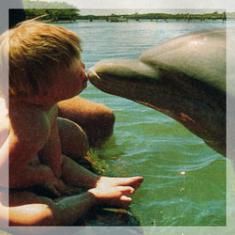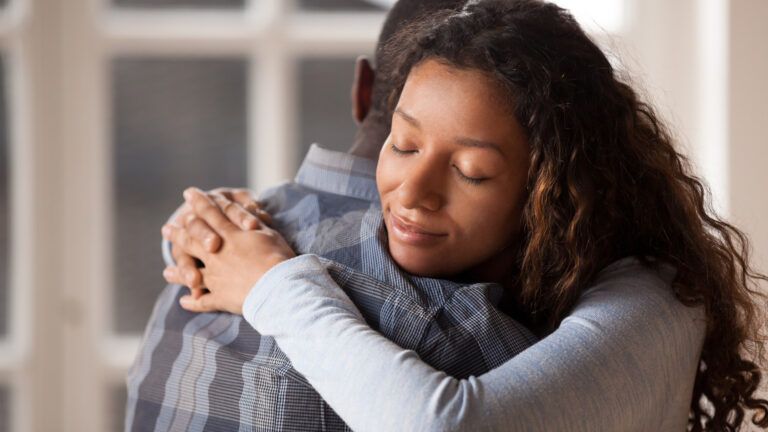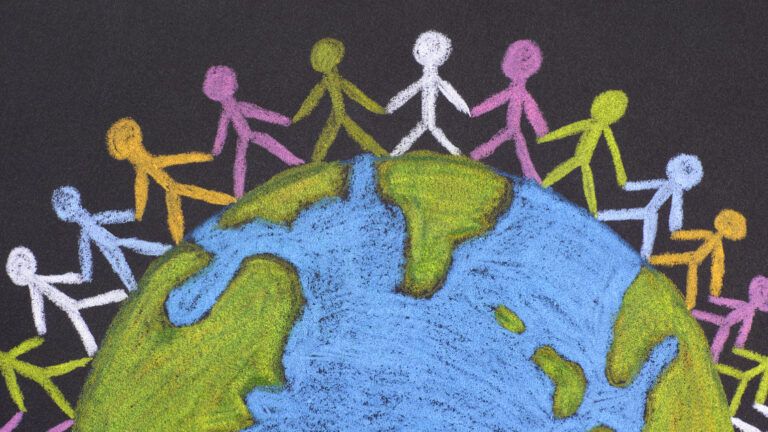For several years an unusual thing sometimes happened during my daily prayers. A vision of dolphins would fleetingly cross my mind, dolphins leaping and playing in the waves.
It was a strange image for me. I had been to the seashore only once, when I was a little girl. We lived in Enid, Oklahoma, at the time, about as far away from dolphins as you can get. I didn’t understand the meaning of the dolphins until a few years after my third child, Deane-Paul, was born.
The moment the nurses let me hold Deane-Paul, I knew he had Down syndrome. From the beginning, our family welcomed him as a special gift from God.
However, by the time Deane-Paul neared the age of three, he hadn’t spoken a word to anyone. There was nothing wrong with his vocal cords. At night I’d hear his little voice as he mumbled in his sleep. I tried to teach him during the day, tried until my heart broke. But awake, around people, he was mute.
A new aquarium had just opened at the zoo in Oklahoma City, about 100 miles south of us. One day the children and I went to see it. When we stopped at the dolphin pool I couldn’t believe what happened. Suddenly Deane-Paul hopped up on the railing that separated us from the pool, and then to my amazement and alarm, he tried to climb over to the dolphins. I grabbed him instantly.
But what amazed me even more than my son’s strange behavior was the dolphins’ reactions. They swam right over. Raising sleek heads with what seemed like sly, quizzical expressions, they chattered and squeaked playfully.
Then one of the dolphins tossed a beach ball to him. Deane-Paul heaved it back. To and fro it went, the boy and the dolphins cavorting like playmates.
The dolphins’ trainer sauntered over, his mouth agape. Instead of his charges rushing up to him for their usual fish handout, they had continued to concentrate on Deane-Paul. The look on my little boy’s face was pure shining joy.
When we returned home I told a good friend about our odd experience. “Well, that’s the strangest thing,” she exclaimed. “I just happened to catch part of the Today show on television yesterday morning. And there was a little boy with Down syndrome swimming with a dolphin.” She scratched her head. “It was a place somewhere in Florida.”
Suddenly I remembered those dolphin scenes that had been flashing through my prayer times.
I called the Today show right away and got the number to the Dolphin Research Center in Grassy Key, Florida. I talked with the director, Dr. David Nathanson, a clinical psychologist from Miami. He claimed his studies showed that when some children with disabilities interact with dolphins, it relaxes them, and language skills become easier to grasp.
“Why don’t you come down?” he suggested.
I hung up the phone. “Easy for him to say,” I muttered. I was a divorced, single mother trying to support my family on a dental hygienist’s salary. How could I afford to fly myself and three children to Florida? Besides, the thought of Deane-Paul actually being helped by dolphins…well, it just seemed too strange to believe.
But those dolphin images kept invading my prayer time. Finally I decided: Why not take the three weeks’ vacation I had coming, drive to Florida with our tent and camp? Even if the dolphins didn’t help Deane-Paul, we might have some good fun.
“We’re going to Florida for spring break,” my daughters Mea, 10, and Andrea, 8, boasted to their classmates. After four days on the road and then driving two-thirds the way down the Florida Keys on U.S. Route 1, we pulled up in front of the Dolphin Research Center. The low cement-block building with sculptured dolphins in front was modest. Frankly, I’d expected to see something more like Disney World. After all, this was the place where TV’s Flipper once lived and trained.
We were welcomed by Dr. Nathanson, a tall man in a baseball cap whose friendly voice quickly made me forget my disappointment. He told us how he came to this extraordinary work. “Ever notice how a puppy grabs a child’s interest?” he asked. “Well, the attention span of children, especially those who are handicapped, is limited. But when I saw how quickly animals intrigued them, I thought of the highly intelligent dolphins who enjoy human affection and contact. Maybe they could help teach. Also, the water’s buoyancy helps kids relax,” he added.
But could dolphins help Deane-Paul, a little boy who wouldn’t talk?
We walked out into the dolphin area, a small inlet on the Gulf. The water was divided by boardwalk piers and low fences into eight separate dolphin pools. “Seventeen Atlantic bottle-nose dolphins live with us,” he said. “They could easily swim out to sea. But they seem to like it here.”
Dr. Nathanson told how one time a sick dolphin bolted over the fence but was gently led back by two others who sensed the animal couldn’t make it on its own.
I thought again of my prayer-time visions of dolphins. I wanted this to work for Deane-Paul, to help him speak so he could get on in the world. But it seemed so unlikely, almost like a funny dream.
A sleek blue-gray shape suddenly broke the water, and Deane-Paul’s eyes widened and his face broke out in a big smile. He and I donned wet suits and poised at the water’s edge. The friendly dolphin—her name was Santini—chattered invitingly.
We plunged in the cool water and Santini immediately circled us. It was exhilarating. But what was that strange tingling feeling?
“Sonar,” yelled Dr. Nathanson from the dock. “Dolphins use it for direction. They emit high-frequency ‘radar’ waves that bounce back to them. With it they can locate something as small as a vitamin capsule on the bottom of the inlet.”
Santini slowly edged her 350-pound, seven-foot body next to us. Her smooth skin felt like a peeled boiled egg. “She wants to pull you through the water,” called the doctor. “Hold onto her dorsal fin.”
For an instant I was apprehensive. But Deane-Paul’s fearlessness calmed me. Holding him in my left arm, I took hold of the tall rubbery fin. Suddenly we were surging through the water. I caught my breath. Dolphins can swim up to 25 miles per hour. We flew around the pool in wide circles, Deane-Paul screaming happily. Santini seemed to be having fun too.
“Now that your son is used to his dolphin teacher, we can get started,” called the doctor as we climbed out of the pool. A young volunteer sat down with Deane-Paul at the water’s edge, holding a series of one-foot-square wooden boards, each bearing a different picture. She took a board with a car on it and had Deane-Paul toss it playfully to the waiting Santini.
Holding it in her mouth, Santini swam back to Deane-Paul and returned the board to him gently. Then the teacher held the board up and repeated the word. “Car…car…car.” It was an incredible process to watch. Back and forth they went.
Still, Deane-Paul wasn’t talking, just laughing and squealing. It’s not going to work, I thought. But at least he’s having fun. Then an amazing thing happened. Deane-Paul suddenly piped up: “ca…ca…car!” He was so thrilled! He proudly glanced back at me over his shoulder and wiggled his whole body.
“Good, wonderful, Deane-Paul,” complimented the teacher. “Now Santini will give you a present.” She flipped a quick hand signal and the dolphin swam up, kissed Deane-Paul on the forehead, then leaped out of the water, twirling.
My son was in awe. And so was I.
Through subsequent training sessions, Deane-Paul spoke more and more. After his first week, Deane-Paul took off with a dolphin, holding onto her dorsal fin, his first solo trip. By then he had developed a close relationship with several of the animals.
Annessa, a dolphin who had just begun working with children, accidentally frightened Deane-Paul one afternoon. He burst into tears. Santini, who was on the other side of the pool, saw it happen, raced over to Deane-Paul, kissed his foot, then his knee and then his face.
After she calmed Deane-Paul down, Santini hustled over to Annessa and chewed her out with squeaks, clicks and chatter. Then Annessa meekly swam to Deane-Paul and apologized by gently kissing his foot while Santini stood by.
Deane-Paul became so much at home at the center he even helped with the work. He loved loading the stainless-steel buckets with herring and capelin and helping feed the dolphins. Then he’d help with cleanup.
Deane-Paul also learned some of life’s harder lessons. The dolphin he became closest to was an elderly female named Bee. They often swam together. Then she became ill. Deane-Paul worried about her day after day. One night he awoke calling, “Oh, Bee…Oh, Bee…,” and tried to walk out into the dark. We kept him in and he sat up by the door sighing for her until dawn. In the morning we learned that Bee had died.
Before we knew it, our time at the center was up. We headed back to Enid. All the way home, Deane-Paul talked and talked about the dolphins. As I drove I wondered, Yes, but how will he act back home in the cold everyday world? I was beginning to worry again, worry that he would retreat into silence.
We had our answer when we drove into Enid and pulled up to a convenience store. Deane-Paul toddled up to the counter and in a clear voice demanded: “Coke Icee, please.”
The clerk handed him his drink as if he were any normal boy. I turned away and quickly wiped my eyes. Dear God, I prayed, thank you for dolphins.




